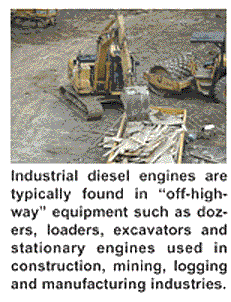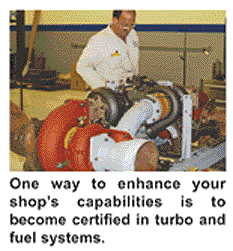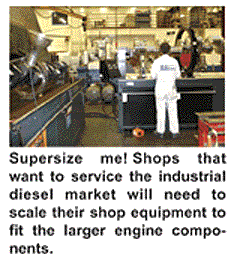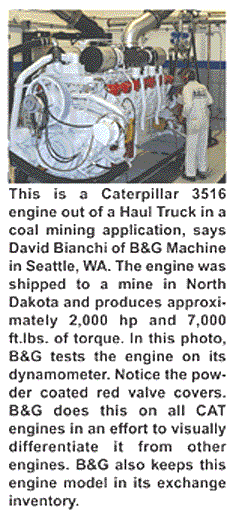When it comes to the various rebuilding markets, almost nothing is as specialized as industrial diesel engines. While many experts say this market is growing at the moment, it can take a supersized commitment to compete in this niche segment because of remanufacturing competition from the OE manufacturers themselves. You’ll need to supersize your tooling as well as your training and rethink how you can best market your services to these customers. However, that should not deter any shop that has a plan and is ready to use it.

“The market for these industrial engines is very healthy,” says R&R Machine’s Bryan Menke, which is a very good thing for the 2006 Engine Builder Machine Shop of the Year. “What piece of industrial equipment runs on gasoline right now? Nothing. Diesel is what we specialize in.”
The fact is, points out Menke and others, that diesel engines can be found everywhere today – from lawn tractors at the country club to larger industrial equipment.
“We’re trying to be the diesel experts,” says Menke. “There’s more of a market in diesels for us and the industrial side is growing every year. Today, diesel industrial engines make up 60 percent of our business.”
Menke says R&R works on a lot of dozers, wheel loaders and excavator applications in the shop with engine such as the CAT 3306, 3406, 3408 and 3508. He rebuilds many construction applications as well.
So just what is an industrial diesel engine? We have classified this segment to include diesel engines that are used primarily for a wide variety of industrial “off-highway” applications in factory, construction and other heavy-duty environments. Agricultural engines, though also off-highway, utilize many of the same engines as industrial applications but for this case we consider them cousins, since the Ag service market is so unique.

However, shops thinking of entering this market need to define their prime market segment for themselves. Although larger diesel engines may be similar to each other, the way you service the market may be unique for each segment.
“For us the industrial market is made up of construction equipment, stationary engines, gen sets, power units that may run crushing equipment and the occasional crane engine,” says Manitowoc Motor & Machine’s Scott Wichlacz.
Though skilled in servicing the large diesel engines, unlike the other experts we interviewed, Wichlacz doesn’t specialize in this market segment. MM&M prides itself on being able to handle just about any job that comes in the door. However, 30 to 40 percent of Wichlacz’ business comes from a combination of heavy-duty, agricultural and industrial applications.
MM&M doesn’t go out in the field to service much of this industrial equipment unless it’s for minor repairs such as crack stitching. “Most of our work is general machine work and the customers do the installs themselves. But industrial engines are a big part of our business.”
He says most of the industrial work his shop gets is from implement dealers because they don’t typically do any machine work themselves. “It’s not worth it for implement dealers to do the machine work, so we do all the rod, head and crank work for them,” says Wichlacz.
One rebuilder who does specialize in industrial engines is Mike Eighmy at Precision Engines in Rockford, IL. Eighmy says that industrial applications represent about 65 percent of his business.
“We do more industrial engines than anything else. The most popular engines for us are the Cummins L10 and M11 in what they call ‘vocational applications,'” says Eighmy. “In our case, these engines are mostly found in ready-mix (concrete) truck applications. We also still see a lot of 471 Detroit Diesels out of Terex scraper applications. We are also a Cummins service dealer so we have access to parts for those engines in good supply. And for the Detroit Diesel there are many aftermarket parts options from several different suppliers.”
Parts are all still available for everything, according to Menke. “We go through the top aftermarket suppliers for everything we can, and for the bigger, newer stuff we go through the dealer. We’ve found that we can still make good profits even through the dealer. And we’ve got good rapport with the local dealer because we do quite a bit of work for them.”
One of the most important things Eighmy and others suggest to those wishing to pursue industrial engine business is to forget the notion that size is unimportant. If you’re looking for industrial work, your equipment and tooling has to be “sized right.”
“Your shop has to be large enough to handle the bigger engines and components you’ll be working on,” says Eighmy.

It can be difficult for some shops that don’t specialize in this market to be successful, because a performance guy, for example, doesn’t have the equipment to service these engines. You need bigger everything, and that takes a big commitment to do it. Experts point out that you just can’t drop what you’re doing on a 350 Chevy and start boring a Cummins and hope it’s correct. You’ve got to watch hardness of some of these blocks and parts.
R&R’s Menke agrees with scaling your shop to handle large engines, looking at layout, equipment needs and your ability to transfer these giant heads, blocks, cranks and other components around in your shop.
In this market the old saying “time is money” definitely holds true. Even a few hours of down time can be many thousands of dollars lost to your customers who own and operate machines, such as cranes and mining equipment, says Menke. “We have to go on site for many of these calls. We’ll send one or two guys out in the truck and depending on how big the need is they can service it right there most of the time.”
A key point: if you go out on a service call you’ll need a truck with a big enough boom on the back to pull heads and engines out of equipment. Many of the industrial engine customers don’t have the ability to service these engines, especially on a drag link or drag crane in a sandpit somewhere.
“If the engine is really bad on some of this immovable equipment, either the customers or one of our guys will pull the engine and bring it back to the shop to rebuild,” says Menke. “But most of the time we’re able to do an in-chassis rebuild, or our customer may bring in certain components like the heads, rods or crank.”
Experts acknowledge that it takes a bit longer to service drive-outs because you have to factor in the travel time, the time it takes to remove the engine or components, repair it and install the rebuilt parts – but you can get paid an hourly rate plus mileage for the extra time it takes.
It definitely adds extra time but for some industrial customers it’s their only choice – and remember the saying, time is money? If these large pieces of equipment, which often run 24-hours a day, 7 days a week, pausing in their jobs only long enough to change drivers aren’t in service, operators are losing money by the minute.
A lot of the industrial companies have their own mechanics but rarely do they have the capability of diagnosing the newer electronic engines. Experts say that most industrial customers just don’t have the computers or electronics necessary to do it, unless they’re a really large company, and even then they may not fully know how to use what they have.
Time and money can also be wasted taking in unfamiliar jobs experts warn. It can become a black hole of chasing parts and information if you get into something too far out. And this can be particularly difficult for shops that don’t have much experience with these engines.
But it’s not all just about equipment. “You have to have a good network of people who you can call and ask, ‘Is this right?’ ” says Manitowoc’s Wichlacz. “You can look at AERA’s Prosis software and get some of the information you need. It has helped us out tremendously in the past when we’ve had questions about industrial engines. In some cases, we may have to go back to the dealer and buy the manual, but usually AERA has the information we need.”
Another issue that our experts raise is that competing against dealers and OE reman programs can be a tough sell. Dealers typically have extensive inventories of parts and can get a head or a set of rods or complete engines in a few hours in some cases. The OEMs and dealers tend to get the bulk of the business so independents need a value proposition to compete. But experts say it’s not impossible to find success on the industrial side.
The key is to know what you don’t know – and how to learn it. Industrial engine specialists say that the way to obtain the necessary knowledge and increase your shop’s menu of services is to go back to school and get certified.

R&R’s Menke says his shop has made a big commitment in the last 10 years to get authorized with every turbo and fuel manufacturer. They’re now certified in Garret Turbos, Bosch Fuel systems and others. “Every other year our test benches are audited to make sure they’re correct. We go to training programs for various manufacturers probably two or three times a year,” Menke explains. “It’s a lot of tooling and a lot of training and keeping up with it. But we have increased our capabilities by quite a bit.”
Another tool that sets some shops apart from others in this market is the importance of dyno testing engines before they leave the shop.
“Dyno testing has been a big key for us,” says Eighmy. “It’s good insurance to make sure we don’t have any leaks and that the engine is running properly, putting out the right amount of power, and it also runs the engine in. We can put a load on the engine and start breaking it in before it leaves. Dyno testing as much as possible is a great quality assurance measure.”
Experts warn that unless you put a load on the engine, you’re not going to find all the defects that may be present in the engine. If you only freewheel it on a test stand you’ll catch a few things but you won’t find as much as you can on a dyno. And in this market shipping engines with defects is a sure way to ruin your reputation.
In many diesel engine markets emissions regulations have had a big impact on the demand for older engines and the need to keep them in service. This hasn’t affected the industrial side as much as the others…yet. Stricter EPA regulations are a couple of years off, but we’re likely to see the same result as with other segments. Emissions are already starting to become an issue as far as purchasing and rebuilding decisions are concerned, according to our experts.
“It’s just like what happened for truck buying with the ’07 EPA regulations,” says Menke. “So many engines were purchased ahead of those standards, and people are keeping their old stuff longer. And the older engines last longer in some cases.”
Precision’s Eighmy says industrial equipment is generally older and rebuilt often. “A lot of the industrial equipment has been around for a long time. Equipment such as that Terex scraper has been rebuilt many times over. And it’s not just the engines that get rebuilt; it’s the frames, transmissions, elevators and everything. The machine is torn down and rebuilt whenever it’s needed. The engines don’t last that long because it’s a severe duty application. The engines may only last a couple of seasons. And this particular scraper has two engines in it.”
Although most industrial equipment is used fairly hard, not all of it is. Eighmy says one piece of equipment, a hydraulic excavator, is actually pretty easy on the engine. “It really depends on the application. When you get into earth moving equipment such as scrapers and dozers, the equipment is used pretty hard. Some of the environments these engines operate, like mines and quarries, can be quite harsh. The dust can really be tough on the insides of these engines.”
Industrial experts all agree that the industrial engine business is a good one, but its not without its pitfalls; namely in the shape of a truck full of money that you’ll need to gear up for the work. Some suppliers have taken notice of this niche market and have geared up themselves. According to one machine tool supplier, the passenger car market is pretty much gone now. It’s down to niche markets like heavy-duty, industrial, performance, etc.
This supplier says his company has redesigned some of its equipment so engine builders can more easily accommodate these supersized engines.
“There’s a lot of growth opportunity for engine builders in the industrial market place,” says Precision’s Eighmy. “It takes significant investment in equipment, inventory and in obtaining the necessary knowledge. But if an engine builder can position his shop as an alternative to the OEM and define their market, he can be successful.”
If you’re thinking about going supersize, you may want to follow some of our Machine Shop of the Year’s advice: “If you’re going to do it, do it 100 percent.”
Special thanks to B&G Machine in Seattle, WA, for all of the great photos and addtional comments and inspiration.













